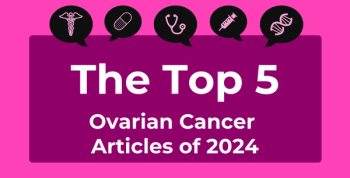
Ovarian Cancer
Latest News
Latest Videos

CME Content
More News

First-line maintenance (1LM) niraparib significantly extends progression-free survival (rwPFS) and time to next treatment (rwTTNT) in patients with epithelial ovarian cancer (EOC), with the greatest benefit observed in those considered homologous recombination-deficient (HRd) and those with BRCA-mutated (BRCAm) tumors.

Nearly half of patients with advanced ovarian cancer treated with first-line poly-ADP-ribose polymerase (PARP) inhibitors experienced recurrence in this real-world study, emphasizing the need for enhanced strategies to optimize postrecurrence treatment.

Researchers identified a 15-year shift toward surgical de-escalation in gynecologic oncology, marked by fewer surgical interventions, increased adoption of minimally invasive techniques, and a greater focus on fertility preservation and sentinel lymph node procedures.

Artificial intelligence (AI) models, particularly artificial neural networks and machine learning, outperform traditional methods in predicting post–complete cytoreduction outcomes in patients with ovarian cancer, including overall survival, no residual disease, and postoperative complications.

High heat shock protein 60 (HSP60) expression in patients with ovarian cancer is associated with larger tumors, advanced stages, and worse survival outcomes, highlighting its potential as a prognostic biomarker.

Patients with stage III epithelial ovarian cancer (EOC) and no visible residual disease after primary cytoreductive surgery had significantly longer real-world progression-free survival and time to next treatment when treated with first-line maintenance niraparib compared with those with higher-risk disease.

Researchers developed and validated a nomogram to predict 1-, 2-, and 3-year overall survival (OS) in patients with ovarian cancer and liver metastases (OCLM), outperforming an external model in stability and accuracy.

Between 1988 and 2017, there were significant global variations and trends in ovarian cancer incidence and its subtypes, influenced by genetic, reproductive, and socioeconomic factors.

The top 5 ovarian cancer articles of 2024 covered topics such as the impact of air pollution on ovarian cancer risk, treatment strategies for patients with liver metastases, and the benefits of early diagnosis through symptom-triggered testing.

Exercise interventions may help manage chemotherapy-induced peripheral neuropathy (CIPN) in patients with ovarian cancer through improved physical activity and muscle function, but evidence remains limited.

In the final part of our interview, Alice W. Lee, PhD, MPH, highlights the importance of addressing ovarian cancer care disparities and beyond by understanding cultural and behavioral factors and adopting a more disaggregated approach to research.

In part 2 of our interview, Alice W. Lee, PhD, MPH, of California State University, Fullerton, examines survival disparities between Hawaiian/Pacific Islander and Asian Indian/Pakistani patients with ovarian cancer and suggests areas for further research.

Alice W. Lee, PhD, MPH, of California State University, Fullerton, discusses her study on ovarian cancer survival disparities among disaggregated Asian American subgroups, emphasizing the need for a subgroup-specific approach in cancer research.

Implementing an individualized starting dose (ISD) of niraparib (Zejula; GSK) reduced severe hematologic adverse event (AE) management costs by 48% compared with a fixed starting dose (FSD) in US patients with ovarian cancer.

The European Commission has approved mirvetuximab soravtansine for select patients with pretreated folate receptor–alpha (FRα)-positive, platinum-resistant ovarian cancer.

If approved, the combination regimen would be the first FDA-approved treatment for adults with recurrent KRAS mutant low-grade serous ovarian cancer (LGSOC).

Initiating palliative care more than 3 months before death improves end-of-life outcomes for patients with ovarian cancer, highlighting the need for earlier interventions.

Researchers found significant differences in ovarian cancer survival among Asian American subgroups, emphasizing the importance of analyzing these groups separately.

Bonnie Qin, PhD, assistant professor at Rutgers Cancer institute, discusses factors that may influence adherence to dietary guidelines and improve survival for Black women with ovarian cancer.

Bonnie Qin, PhD, of Rutgers Cancer Institute, emphasizes that moderate improvements in prediagnosis dietary quality can significantly enhance survival rates among Black women diagnosed with high-grade serous ovarian cancer.

In a recent meta-analysis, the prevalence of human papillomavirus (HPV), especially types 16 and 18, was significantly increased among patients with ovarian cancer (OC) vs controls.

Moderate prediagnosis adherence to dietary guidelines was associated with improved survival rates among Black women with high-grade serous ovarian cancer, the most common and lethal type of ovarian cancer.

By 2021, neoadjuvant chemotherapy followed by interval cytoreductive surgery became the most common initial treatment for patients with advanced epithelial ovarian cancer, overtaking primary cytoreductive surgery.

Higher levels of ambient nitrogen dioxide may be linked to an increased incidence of ovarian cancer, while associations with other pollutants remain inconclusive.

The phase 2 PICCOLO trial demonstrated that mirvetuximab soravtansine (Elahere; AbbVie) is effective and tolerable in heavily pre-treated patients with folate receptor alpha-positive (FRα+), platinum-sensitive ovarian cancer.


















































